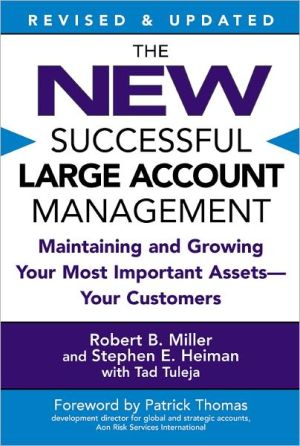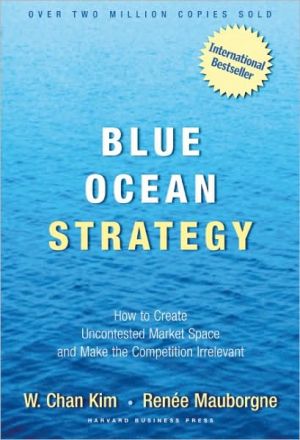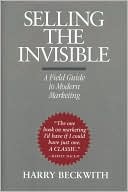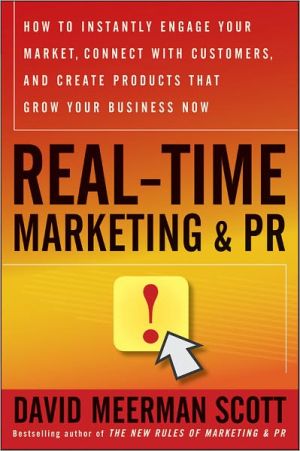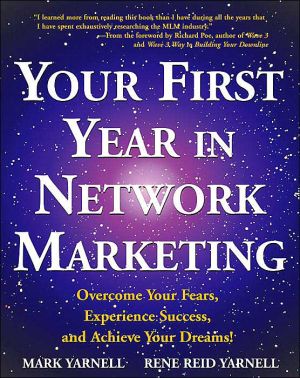The New Successful Large Account Management: Maintaining and Growing Your Most Important Assets -- Your Customers
For the Accounts You Can't Afford to Lose: The Strategies that Will Keep Your Customers Coming Back Whether your company has $50,000 or $5 million in sales, chances are that at least half of your revenue comes from a few crucial accounts. What does it take to keep them going strong? The authors of The New Strategic Selling and The New Conceptual Selling present a hard-hitting, no-nonsense book of techniques to improve your most important business relationships. Updated with recent examples of...
Search in google:
For the Accounts You Can't Afford to Lose: The Strategies that Will Keep Your Customers Coming Back Whether your company has $50,000 or $5 million in sales, chances are that at least half of your revenue comes from a few crucial accounts. What does it take to keep them going strong? The authors of The New Strategic Selling and The New Conceptual Selling present a hard-hitting, no-nonsense book of techniques to improve your most important business relationships. Updated with recent examples of actual success stories, this new edition explores how online click speeds have resulted in highly sophisticated customers who expect all services to be done in "real time." Discover: • The Long View: Studying and really understanding your company-and your customer's business-can mean years of selling success • "Lamp" Strategies: Activate a Large Account Management Process strategy to turn your best customers into permanent "external assets" • Trends and Market Forces: Constantly identify and reappraise the conditions that can make your services more crucial than ever • Channels of Communication: The right contacts and communication lines will help you make key changes-before it's too late!
The New Successful Large Account Management (Revised & Updated)\ \ By Robert B. Miller Stephen E. Heiman Tad Tuleja \ Warner Books\ Copyright © 2005 Miller Heiman, Inc.\ All right reserved. \ ISBN: 0-446-69466-5 \ \ \ Chapter One\ The New Landscape of Account Management: Eight Lessons\ "Change alone is unchanging." -Heraclitus\ IN THE PAST FEW DECADES, ACCOUNT MANAGEMENT HAS BEEN TRANSformed by the most incredible explosion of technological wizardry to appear since the Scientific Revolution of the seventeenth century. Today, even small- to medium-sized firms routinely equip their sales, marketing, and account management people with Web sites, intranets, mobile phones, call centers, PDAs, and e-mail. These aren't options. They're widely acknowledged to constitute an essential, bare-minimum tool set for the twenty-first century. If you don't have these tools today, you're probably not in business.\ Yet, contrary to what its providers would like us to believe, the new technology does not in itself provide competitive advantage. In fact, the very ubiquity of information and communications technology (ICT) systems means that owning the tools themselves is merely an entry fee-something that your company needs to even be in the game. If you're competing for major account revenue today, therefore, you've got to rely on something other than the latest generation of IT products and services.\ There are multiple, interconnected aspects to that "something other," but one thread ties them all together. To achieve competitive advantage today, especially in targeting large or "strategic" accounts, the key differentiating factor is the ability to build relationships that bring your customers measurable value over time. In a sense there's nothing new about this imperative; bringing customers value has always been a key to success. But the world in which we now must do this has in fact changed-and changed in ways that are only marginally related to technology.\ These changes present significant challenges to business professionals, and in this opening chapter we'll detail the most important ones. These are the "field position changes" that, as an account manager or member of an account team, you need to be thinking about before you can even begin to draft plans for approaching your Large Accounts. We present them here as eight essential lessons.\ Lesson One: Technology Changes Everything\ While good account management, like good selling, has always depended on effective information management, in today's hyper-connected, information-saturated, wireless environment, that requirement has been pushed to an entirely new level. Not only is there now infinitely more information out there than ever before, but that information is both instantly and ubiquitously accessible. Now, thanks to Google, Yahoo!, Hoover's, and a host of other unlikely-named databanks and search engines, the newest market entrants can acquire, within minutes, the kind of rich customer data that used to take days, and that pre-Web sales and marketing teams could only dream about. Which means that, with very little investment of either time or money, they can acquire as much public information about your accounts as you have yourselves.\ Private information, of course, is another matter-and showing you how to get that information is a large part of this book. But as far as the public domain goes, with few exceptions, it has never been easier to become knowledgeable about what makes businesses tick-what's worrying their executives, what markets they're investigating, where they're being hammered by competitors, what new products they're bringing to market. All of this stuff is available at click speed-to you, to your current competitors, and to all those new potential players.\ Here's another hard truth: Your customers have access to this new information, too. They're using it to research your capabilities, to compare them against those of your competitors, and to bring to the bargaining table a much higher degree of sophistication than businesses have ever had to contend with before. The accounts that you acquired fairly easily during the 1990s boom are both more resource-poor and data-rich than they were then-and fully capable of using that scenario to their competitive advantage.\ The information bonanza that Web developers are fond of bragging about, therefore, has brought account managers an opportunity that is also a challenge. It's a much more open field than it was a decade ago, but one in which the pure volume of information that technology makes available can become a problem in itself. So, to help you sort the wheat from the chaff, rather than gathering more data just for the sake of gathering it, you need an information management system that can help you transform all that free-floating data into usable business knowledge.\ Lesson Two: Technology Changes Nothing\ By information management system, we don't mean software. Perhaps the greatest single mistake of the dot-com years was the idea that technology in itself was going to make us all rich. In pursuit of that dream, company after company invested heavily in software that was designed to "automate" the sales and marketing process. First it was Sales Force Automation (SFA), then Customer Relationship Management (CRM), and then Enterprise Relationship Management (ERM). Some companies did very well with these new systems, but a shockingly large percentage of these fixes fell flat, bringing little to no returns on massive IT investments.\ Systems failed for three related reasons. First, the purchasing companies allowed themselves to believe that the software would somehow run itself, and therefore failed to invest adequately in the ancillary services that CRM providers were only too eager to sell them-services like integration assistance, data cleansing, and most importantly training. Second, poorly trained and often suspicious sales and marketing people decided that the new "automation" software was just another gimmick-and one that would require them to enter data while getting nothing in return. So they just didn't use it-a phenomenon that became known in Silicon Valley as the "user adoption problem." Third, many companies, intoxicated by CRM's shiny bells and supersonic whistles, failed to analyze the processes that they were automating; what they got, therefore, was the same old selling blunders, only faster.\ The lesson isn't to avoid CRM software, or any other technology. Used properly, good software can be as effective an account management tool as a clear-signal mobile phone or a broadband connection. But that's all it is. Software can no more turn an incompetent salesperson into a double-quota winner than a $200 driver can turn your average five-year-old into Tiger Woods. Results are never provided by a tool in itself. They're provided by the effective use of that tool in the hands of a professional who follows a replicable, tested process for ensuring success, and who knows that, however sophisticated your toolbox, it's still the effective management of relationships that drives long-term business.\ That's an old lesson, of course. We've been teaching it in all our programs for more than twenty years. It bears repeating here because today, perhaps more than ever before, you need good tools to keep your competitive edge, and it's easy to be fooled into believing that they'll do the job for you. Because we know they won't, we focus in this book, as in our programs, on defining an account management process that is generalizable-a process for building solid, mutually beneficial relationships that can be supported by whatever technology you adopt.\ Lesson Three: Customers Are Still in Charge\ In the early days of the Internet, the more optimistic champions of online commerce predicted that, sooner or later, all transactions would move to this lower-cost channel, and the centuries-old brick-and-mortar model would become obsolete. The fact that this didn't happen tells us something critical about customer psychology-something that has tremendous implications for Large Account management.\ What Internet transactions offer people isn't so much a replacement for their customary buying and selling behavior as an expansion of choices-this explains their popularity. Sometimes customers go online to make actual purchases on the spot; pioneering Web business leaders like Amazon built their reputations by offering that service. But even in some other leading online firms, like the electronic brokerage Charles Schwab, a heavy proportion of trading happens offline- at the branch offices that some individuals prefer. Some customers, moreover, use the Web as a research tool, gathering comparative data about prospective purchases and potential suppliers that enables them to make more informed buying decisions. And not all the decisions they make favor buying online.\ In fact, over the past few years, airline and hotel customers, to pick only the most obvious examples, have become adept at using the Web as a bargaining tool. Armed with a low online quote, they can more effectively demand deeper discounts in the brick-and-mortar world. A similar comparison-shopping strategy works on the B2B level, where Internet auctions have dramatically intensified competition for corporate contracts.\ Whether you're looking at individual consumers or Large Accounts, the outcome is the same. Even though only a relatively small portion of today's business takes place online, the mere presence of the Web as an alternate transaction channel has upped the ante for suppliers across all channels. The hard fact for businesses, online or off, is that the Internet makes customers more discerning and more demanding. Because they have become used to the instant, personalized, and cheaper responses available on the Web, they have come to expect equivalent levels of speed and service wherever they do business. One of the great ironies of the computer age is that machines have made customers more insistent on personal responsiveness.\ For all businesses, therefore, the old adage about the customer always being right has taken on a special urgency. Customers today have been "reconditioned" by the Web. They are better informed, more aware of their options, and therefore more empowered than customers have ever been before. Making matters even more challenging in the B2B world is the fact that, when customers are asked to identify vendors' shortcomings, the single biggest complaint they make, according to HR Chally research, is that salespeople don't understand their businesses. This can have a chilling effect on customer receptivity. And, in more situations than most of us would like to admit, it means that the old loyalty effect is a fleeting phenomenon.\ In fact, customer defection, or "churn," is a major problem everywhere. In the telecommunications industry, which coined the term, it's particularly severe. Our client Ged Holmes, who implemented LAMP when he was head of business sales at the British mobile network leader O2, cites "staggering" industry churn averages of between 18 and 24 percent. "It's only through a tremendously disciplined approach to the account as a whole," he says, "that telcom providers are able to keep that under control. You've got to realize that your job isn't to write new contracts, but to sustain the profitability of the business you already have. In a customer-centric world, that's a constant challenge. And the only way you can meet it is to respond to customers' demands for consultative service. It's not about giving them more technology. It's about using technology to help them plan the future."\ Lesson Four: Short Lists Are Getting Shorter\ The rise of supply chain management, both as a technology and as a business strategy, has fundamentally altered the way suppliers are obliged to do business. A dozen years ago, your proposal might be judged based largely on its intrinsic merits: price, product reputation, compliance with an RFP's specs, ability to deliver against a deadline, and so on. That's no longer enough. Today's leading corporations are systematically gauging the total cost of doing business with their competing suppliers- and are moving toward ever shorter short lists of those who make the grade. This conscious narrowing of the vendor base is happening across the board, whether the cost to be covered entails a communications network, office supplies, or a potentially outsourceable HR function.\ For anyone trying to manage a Large Account, the widespread adoption of supply chain management means that procurement has become a central factor in sales. As procurement specialists look for ever more ingenious ways to trim costs, the natural tendency-often a conscious one-is toward commoditization. This tendency, increasingly, is becoming quite scientific. Not only do companies rely on back-office automation systems to drive personnel costs out of routine procurements. In addition, many European firms now tap the resources of purchasing institutes to help them rationalize the supply chain management process. And the largest firms maintain huge procurement departments, specifically tasked by the C level to drive costs down.\ Don McKelvie, a LAMP client and Director of Worldwide Sales of the leading oilfield service supplier Baker Atlas, notes that the procurement specialty has emerged, at least in part, as a result of the merger and acquisitions mania. "In the acquisitions process," he points out, "many oil companies spent millions of dollars more than the acquired company's assets were worth. One way of showing Wall Street that the resulting synergy justifies their investment is to hammer their suppliers into volume discounts. This is why the super majors and some larger independent oil companies pay literally hundreds of employees to manage procurement. That creates a challenge for vendors, because some procurement departments justify their entire existence by pushing suppliers down into a commodity position."\ In the new procurement-driven world, "getting out of commodity" is a major challenge. We'll address it throughout this book, when we speak about maintaining your position on the Buy-Sell Hierarchy.\ Lesson Five: It's Not About Making the Sale\ In an arena where every buyer impulse is driving you toward commodity, focusing on individual transactions only ensures that status. To ensure success-even survival-in today's Large Account arena, you've got to set your sights on three or four years out, and on building long-term business, not just today's "opportunities." The reason is logical enough: Adding up quick serial wins gets you perceived as shortsighted, while working for the account's long-term benefit helps to ensure account retention. And in today's environment, retention is the name of the game.\ Bill Clement is Director of Enterprise Development for Siemens Building Technologies. He draws a good distinction between companies that are truly relation-based, or customercentric, and those that he calls "opportunistic."\ Continues... \ \ \ \ Excerpted from The New Successful Large Account Management (Revised & Updated) by Robert B. Miller Stephen E. Heiman Tad Tuleja Copyright © 2005 by Miller Heiman, Inc.. Excerpted by permission.\ All rights reserved. No part of this excerpt may be reproduced or reprinted without permission in writing from the publisher.\ Excerpts are provided by Dial-A-Book Inc. solely for the personal use of visitors to this web site. \ \
